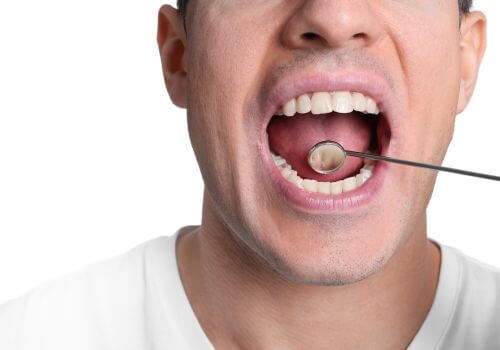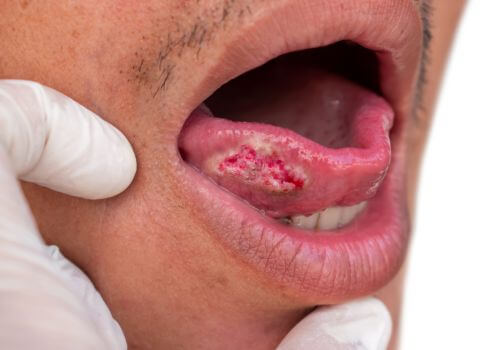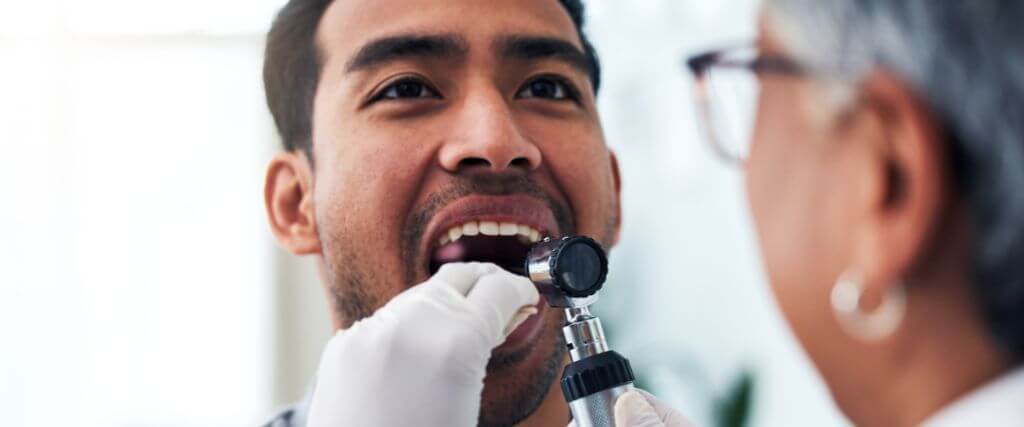Oral cancer affects more than 54,000 Americans each year and accounts for roughly three percent of all new cancer cases in the United States. But despite these alarming statistics, many people remain unaware of the importance of regular oral cancer screenings or the warning signs that could save their lives.
Early detection dramatically improves survival rates, with five-year survival rates jumping significantly when cancer is caught in the initial stages. Understanding what oral cancer screening involves and recognizing the early warning signs is often the difference between a minor procedure and extensive treatment.
What Is Oral Cancer Screening?
Oral cancer screenings are painless, quick exams during which your dentist checks for signs of cancer in your mouth, throat, and surrounding tissues. The process takes just a few minutes during your regular dental visit, but its impact on your health can be life-changing.
During the screening, your dentist examines all oral soft tissues, including your lips, gums, cheeks, tongue, and floor and roof of your mouth. They also check your throat, neck, and jaw area for any unusual lumps, bumps, or changes in texture or color.
Modern screening techniques go beyond visual examination. Many dental offices now use advanced technology like VELscope fluorescence imaging, which uses blue LED light to identify abnormal tissue that may not be visible to the naked eye. This technology helps detect changes in tissue at the cellular level before they become visible symptoms.
Who Needs Oral Cancer Screenings?
Everyone should receive regular oral cancer screenings, but some individuals face higher risks and benefit from more frequent examinations. Age plays a significant factor, with most oral cancers occurring in people over 40, though younger individuals can also develop the disease.
Your lifestyle choices also significantly impact your risk level. People who use both tobacco and alcohol have a 15 times higher chance of developing oral cancer than those who do not.
The human papillomavirus (HPV) has emerged as another major risk factor, particularly for cancers affecting the back of the tongue and throat. The HPV-16 strain, the same virus linked to cervical cancer, now accounts for a larger percentage of oropharyngeal cancers. A family history of cancer, poor nutrition, and a compromised immune system also increase your risk.

The Screening Process: What to Expect
An oral cancer screening usually begins with a discussion about your medical history, lifestyle, and any symptoms you’ve noticed. It’s important to share details about tobacco and alcohol use, as this helps your dentist accurately assess your risk.
Next, your dentist will perform a physical exam, checking your face, neck, and lips for any changes in color, shape, or texture. Using a bright light and mirror, they will carefully examine the inside of your mouth, including your tongue, cheeks, gums, and the roof and floor of your mouth.
Special attention is given to areas where oral cancer often appears, such as the sides and underside of the tongue, the floor of the mouth, and the soft palate. Your dentist will also gently feel your neck, jaw, and under your chin to check for any lumps or swollen lymph nodes.
If your dentist uses advanced screening tools like VELscope or special rinses, they will explain how these technologies help detect suspicious areas that may need a closer look or a biopsy.
The screening is quick, typically taking less than five minutes, and should not cause any discomfort. If your dentist finds anything concerning, they may recommend additional tests or refer you to a specialist for further evaluation.
Warning Signs You Shouldn’t Ignore
Recognizing the early symptoms of oral cancer can save your life. Many symptoms appear subtle at first, which is why regular professional screenings are so important.
Potential signs of oral cancer include:
- Persistent mouth sores that don’t heal within two weeks
- Changes in oral tissue color or texture
- Unexplained bleeding in your mouth
- Difficulty swallowing
- Persistent sore throat
- Numbness in your mouth or tongue
- Difficulty moving your tongue or jaw
- Chronic bad breath
- Voice changes
- A lump in your neck or the sensation of something stuck in your throat
Pain isn’t always present in early-stage oral cancer, so don’t wait for discomfort before seeking help. Many patients report that their cancerous lesions felt different but didn’t hurt initially.
The Power of Early Detection
With early detection, oral cancer is often a highly treatable condition. When caught in Stage 1, the five-year survival rate exceeds 80%. Unfortunately, the survival rate drops significantly as the cancer progresses, highlighting the critical importance of regular screenings.
Treatment for early-stage oral cancer often involves minor surgery with minimal impact on speech, eating, or appearance. Advanced cases may require extensive surgery, radiation therapy, or chemotherapy, with more significant side effects and longer recovery times.
Beyond survival rates, early detection preserves quality of life. Patients diagnosed early are more likely to maintain normal speech and swallowing functions, while those with advanced cancers may face permanent changes in these abilities.
Prevention Strategies That Work
While regular screenings are vital for early cancer detection, there are also ways to minimize your risk of developing the disease. Stopping tobacco use drastically reduces your risk. Within five to ten years of quitting, your risk becomes similar to that of those who have never smoked.
Limiting alcohol consumption also helps. If you drink alcohol, stick to moderate consumption levels and avoid combining alcohol with tobacco use, which multiplies your risk exponentially.
Maintaining good oral hygiene supports overall mouth health and may help prevent cancerous changes. Brush twice daily with fluoride toothpaste, floss often, and visit your dentist as recommended based on your oral health needs.
Fruits and vegetables contain beneficial antioxidants that may help protect against cancer. Some studies suggest that foods high in beta-carotene, vitamin C, and vitamin E may also reduce oral cancer risk.
Lastly, consider getting vaccinated against HPV if you’re eligible. The vaccine prevents infection with the HPV strains most commonly linked to oral cancers.

Making Screening a Priority
Include oral cancer screenings in your regular preventive healthcare routine. Most dentists recommend getting screened once a year if you’re at average risk, while those with higher risk factors may need more frequent checks.
Between dental visits, it’s helpful to perform a monthly self-exam at home. Use a mirror and a bright light to look at all areas of your mouth, and contact your dentist promptly if you notice any changes or unusual symptoms.
Closing Thoughts
Taking charge of your health through regular oral cancer screenings and healthy lifestyle choices gives you the best chance of preventing oral cancer or catching it early when treatment is most successful. Don’t wait; schedule your screening today to take the first step in protecting your smile and your life.

